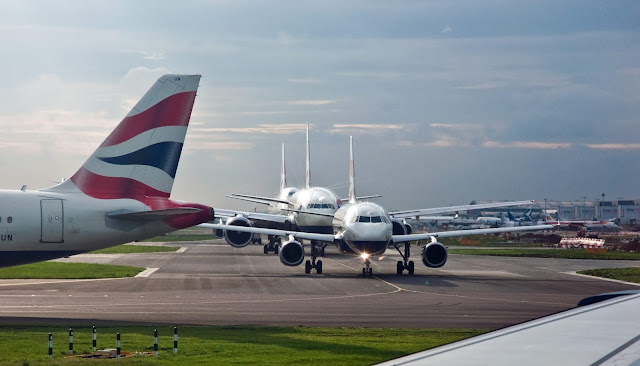PROCEDURE FOR TAXI AND LINE-UP
Aircraft taxi is a procedure of moving aircraft from one place to another under its own power. But can an aircraft move during taxi in the way it wants? Or are there any rules which bound the movement of an aircraft in an airport.
Procedure to begin Taxi:
The place of an airport where the loading and parking of an aircraft take place is called the gate position of that aircraft. When boarding of all the passengers is over and an announcement to fasten the seat belts is done, then it is the time for aircraft to start its taxi. Now after getting the clear signal by the pushback driver, a request to get a taxi clearance is extended to the ground and apron controller. When the ground controller gives the taxi clearance to an aircraft, then aircraft moves out of its gate position and the taxi lights are switched ON. Parking brakes are released and taxi along the assigned route is started.
Procedure to begin Taxi:
The place of an airport where the loading and parking of an aircraft take place is called the gate position of that aircraft. When boarding of all the passengers is over and an announcement to fasten the seat belts is done, then it is the time for aircraft to start its taxi. Now after getting the clear signal by the pushback driver, a request to get a taxi clearance is extended to the ground and apron controller. When the ground controller gives the taxi clearance to an aircraft, then aircraft moves out of its gate position and the taxi lights are switched ON. Parking brakes are released and taxi along the assigned route is started.
Just as an aircraft starts to taxi it is slowed down to check whether the brake is working properly. There are various other checks including that of flight controls in which ailerons and all other flight controls are moved to check their working. There is a single engine taxi procedure for turboprops in which the only one of the propellers is spinning. These procedures could vary according to the type of aircraft and airliner. Taxi phase also includes the de-icing procedure where aircraft enters the de-icing pad for getting de-iced. During taxi, the maximum speed allowed is 30 knots. For preventing the nose-wheel from being collapsed turns are made at a speed not higher than 10 knots. Holding point is the last phase of the taxi. Holding point is the position where an aircraft waits for its turn to come on the runway. At this phase tower controller, which is responsible for giving line-up, take off and landing clearances are consulted.
Procedure for Line-up:
The taxi phase ends when the aircraft has received the line-up clearance from the tower controller. Tower controller asks the cabin crew if they are ready for departure. Once the crew has completed the Before Take-Off Checklist, they would respond to the tower controller: “Airliner XYZ ready for departure”. Line-up starts when the aircraft moves past the holding point and ends once the fuselage of the aircraft is in line with the centreline of the runway. There are many special clearances which are provided by the tower controller. For example, to prevent any disaster on the runway, the tower controller makes the crew aware of all the aircraft which would be landing before their line-up and which aircraft would already be there on the runway. These are the differences between Taxi and Line-up. Taxi is the phase to get clearance from the ground controller and reach the holding position just before entering the runway. Line-up is getting in touch with tower controller, enter the runway and get ready for takeoff.
Buy this T-shirt here!
Buy this T-shirt here!
Some misleading terminologies:
There are some terminologies which sometimes confuse the pilot, these are mentioned below.
HOLD SHORT - According to this command of ATC (Air Traffic Controller), the crew should taxi the aircraft to the holding position and wait there.
LINE UP & WAIT – According to this command the aircraft should be made to taxi onto the runway, line up on the centreline, have the aircraft prepared for immediate takeoff, and expect takeoff clearance within seconds.
But many times the crew keep the aircraft at the holding position even after getting “Line-up and wait” command, which sometimes causes a delay in take-off.








